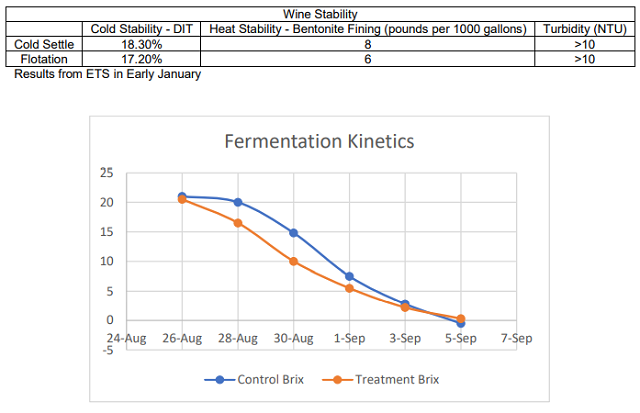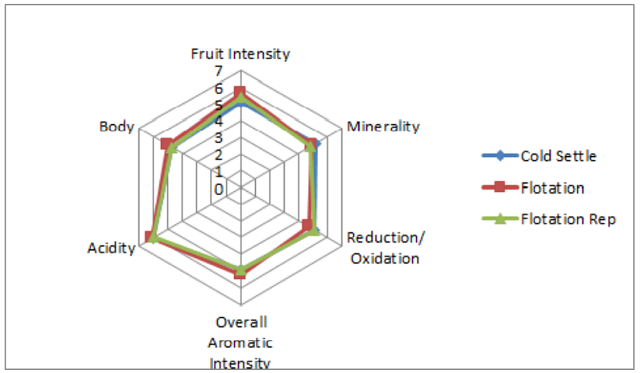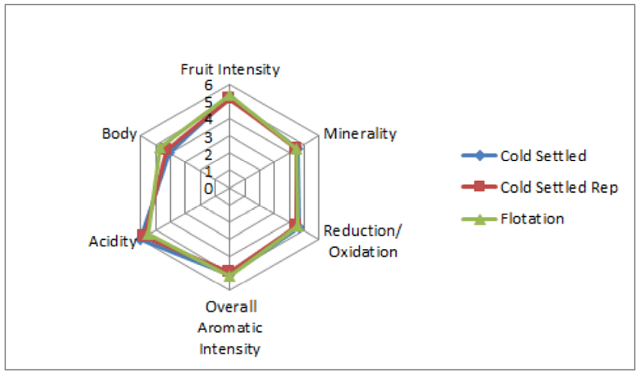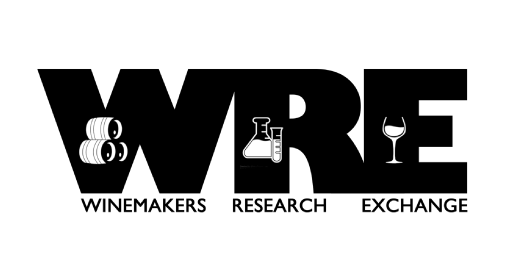Comparison of Juice Settling Techniques (Cold Settling vs Flotation) (2017)
Joy Ting
Michael Shaps Wineworks
Summary
This study examines the impact of different juice clarification techniques in Pinot Gris: cold settling vs flotation. Juice from the same lot of whole cluster-pressed grapes were split into two tanks, one for cold settling and one for flotation. The cold settled juice settled for one day, whereas the floated juice was clarified overnight. All other treatments between juices and wine were equal. The acidity dropped slightly for both treatments after clarification. The cold-settled wine had a slight lag before fermentation began compared to the float. There were no major wine chemistry differences between treatments. The cold-settled wine was slightly less cold stable and required slightly more bentonite to become heat stable. Overall, judges were not able to distinguish the wines from each other. There were no major preference trends for the wines. No strong sensory differences were present as well, except that cold settling may lower the perception of Body. These results suggest that flotation may be a beneficial technique not only to reduce turn-around time, enhance juice yield, and reduce chiller load; but that it may also serve as a mechanism for preserving aromatic intensity and fruit intensity similar to cold settling.
Introduction
Clarification of white wine juice can be done using cold settling, flotation, or centrifugation. The traditional approach at Michael Shaps Wineworks has been cold settling at or near 32°F for 1-2 days. This takes considerable chiller capacity and time, exposes the juice to potential for oxidation (due to racking of cold juice), and ties up a tank for 1-2 days. This study explores the use of flotation as an alternative to cold settling. This approach uses bubbling of an inert gas through juice that has been treated with additives to float particulates out of the juice. To achieve flotation, juice must be treated with pectinase to break down haze forming proteins, and then treated with gelatin and bentonite to form floc along with silica gel to protect from overfining. Gas is bubbled for 2-3 hours, then the tank can be racked from the bottom valve until solids are encountered. Properly executed, this technique has comparable loss rates to cold settling (sometimes lower rates), but occurs in a fraction of the time, freeing up tank space for the next press run.
Results and Discussion
The acidity dropped slightly for both treatments after clarification. The cold-settled wine had a slight lag before fermentation began compared to the float. There were no major wine chemistry differences between treatments. The cold-settled wine was slightly less cold stable and required slightly more bentonite to become heat stable.


For the triangle test on January 31, of 30 people who answered, 14 people chose the correct wine (47%), suggesting that the wines were not significantly different. In general, people who answered correctly had a slight preference for the floated wine. For the descriptive analysis, there were no strong trends for the descriptors used in this study. Fruit Intensity may have been slightly increased by Flotation.


For the triangle test on February 7, of 23 people who answered, 9 people chose the correct wine (39%), suggesting that the wines were not significantly different. Of people who answered correctly, 5 preferred the cold settled wine, 3 preferred the float, and one had no preference. For the descriptive analysis, there was a strong tendency for the cold settled wine to have higher Acidity and lower Body (LSD=0.39 and 0.30, respectively). Other parameters were not much affected.

Overall, judges were not able to distinguish the wines from each other. There were no major preference trends for the wines. No strong sensory differences were present as well, except that cold settling may lower the perception of Body. These results suggest that flotation may be a beneficial technique not only to reduce turn-around time, enhance juice yield, and reduce chiller load; but that it may also serve as a mechanism for preserving aromatic intensity and fruit intensity similar to cold settling. More study will be necessary to confirm these patterns and trends, and more work should be done on different, more aromatic grape varieties as well.
Methods
This is a comparison of techniques, so there were several differences between tanks. All juice originated from the same pick of Pinot Gris grapes. These grapes were harvested on August 21 and refrigerated overnight and processed on August 22. Harvest bins were weighed as a group, then pressed in the same press cycle and distributed evenly among experimental tanks. No YAN adjustments were needed.
For the cold-settled control, grapes were whole cluster pressed into tank with the addition of sulfur dioxide and Cinn-Free (0.012 ml/L) in the tank. Glycol jackets were turned to 48 degrees for cold settling for one day. After 1 day, juice was racked into a fermentation tank. That tank was gauged, pH and TA determined, and tartaric acid added as needed to achieve a target pH (3.34 target). Must was inoculated with 58W3 yeast at 0.25g/L. Brix were adjusted with sugar to achieve a target potential alcohol of 12.5%.
For the flotation, grapes were whole cluster pressed into tank with the addition of sulfur dioxide and Lafase XL Clarification (at a rate of 0.025 mL/L), a strong pectinase designed for flotation. After 2-3 hours, a pectin test was performed (using the Laffort Pectin Test Kit) to determine if all pectin had been broken down. The test was re-run every 30 minutes until no pectin precipitate was formed. Once pectin was cleared, must was treated with 0.05 g/L Vegecoll and 0.5 mL/L Siligel along with 0.3 g/L bentonite. Must was pumped through the Kiesel Float Clear with the addition of nitrogen gas for 1.5x turnover of the tank. Juice was allowed to float overnight. Juice was then racked from the bottom valve until floc was encountered. Tartaric acid was adjusted to achieve a target pH of 3.34, then juice was inoculated with 58W3 at 0.25 g/L. Brix was adjusted with sugar to achieve a target potential alcohol of 12.5%.
Both wines were sulfured and racked on September 10 to topped stainless steel tanks and stored at 51°F. Samples were taken prior to cold stabilization and bentonite fining.
These wines were tasted on January 31 and February 7. For the triangle test, descriptive analysis, and preference analysis for the January 31 tasting, anybody who did not answer the form were removed from consideration for both triangle, degree of difference, and preference. Additionally, anybody who answered the triangle test incorrectly were removed from consideration for degree of difference and preference. Additionally, any data points for preference which did not make sense (such as a person ranking a wine and its replicate at most and least preferred, when they correctly guessed the odd wine) were removed.
In order to balance the data set to perform statistical analysis for descriptive analysis on the January 31 tasting, any judge who had not fully completed the descriptive analysis ratings were removed. In order to then make the number of judges between groups equivalent, two judges from group 2 were eliminated. This resulted in a final data set of 3 groups, each with 8 judges (considered as replications within groups, and groups were considered as assessors). Data was analyzed using Panel Check V1.4.2. Because this is not a truly statistical set-up, any results which are found to be statistically significant (p<0.05) will be denoted as a “strong trend” or a “strong tendency,” as opposed to general trends or tendencies. The statistical significance here will ignore any other significant effects or interactions which may confound the results (such as a statistically significant interaction of Judge x Wine confounding a significant result from Wine alone). The descriptors used in this study were Fruit Intensity, Minerality, Reduction/Oxidation, Overall Aromatic Intensity, Acidity, and Body.
The same procedures for data analysis were used on the February 7 tasting. For the descriptive analysis in this tasting, one judge was transferred from group 3 to group 1, and one judge was eliminated from group 2 and group 3 so that each group had 7 judges, for a total of 21 judges.
